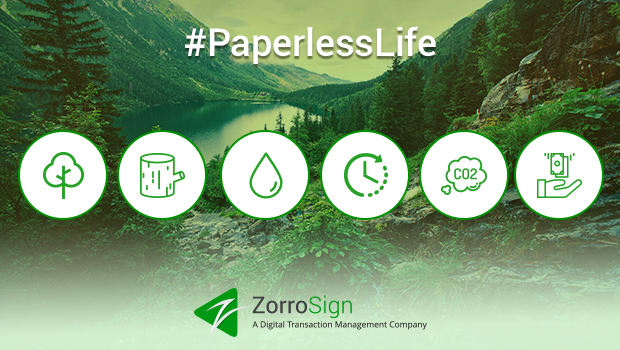- Published on
Environmental impact of using office paper for business transactions
- Authors
-
-
- Name
- Shamsh Hadi
-

A document is sent out as an email attachment asking the recipient to “sign it and send it back.” A new hire packet is sent out for acknowledgement and signature with 52 pages in it. A sales contract is sent out for approvals to multiple people before it goes to the customer. A real estate transaction requires multiple people sign a huge stack of papers. Non-disclosure agreements, invoices, service agreements, and consent forms; they all are sent out for signatures and approvals. All of these “business transactions” involve 2 or more individuals to sign. Most of these cases result in Print-Sign-Scan or Ship then Print-or-Copy-and-store away. A number of businesses have started using some form of eSignature solution but still insist on printing a copy for backup. With average document retention policy being 7 years, office floors are lined with huge steel file cabinets. On average one office worker uses roughly 9000 sheets of copy paper in a single year.
In this article I will focus on environmental impact of using physical paper for all such business transactions. In the next installment, I will cover the analysis of hard cost associated with using paper.
Trees or Wood
It is estimated that one tree produces roughly between 8000 and 8333 (average 8166) regular copy paper. Considering that most of the world uses A4 size paper, the number would be close to 8000 or less. This number assumes a certain size of tree. It does not take into consideration many other types of trees with varied shapes and sizes. Assuming 8166 pages per tree, an office of 100 employees would use about 113 trees worth of paper each year which amounts to roughly 1.25 MM lbs (569.5 kg) of wood each year. As you can see how quickly these numbers add up.
Water
It is estimated that a paper manufacturing plant would use about 3 gallons of non-recycled water to produce one sheet of copy paper or 1.5 gallons of recycled water. Using the example of wood usage above, a typical office of 100 employees would be responsible for using roughly 2.77 MM gallons of water per year to use all that office paper.
Carbon Emission
Calculating Carbon footprint for a life of a copy paper (from a tree getting chopped off, going through the manufacturing process, to distribution) is a very difficult task due to the complex nature of all the processes involved. The fact that every paper manufacturer produces a wide variety of paper products adds to this complexity. However, one factor that makes it easy to estimate Carbon emission is the fuel consumption during transportation of documents for signature. This means trucks, cars, and airplanes used by the courier services like FedEx. Based on the above example, this single office would be responsible for roughly 629 tons of Carbon emission per year.
How Can You Help?
Consider living a Paperless Life! Step 1 is to know how much you could be saving based on your current use of paper. ZorroSign has developed an Environmental Savings Calculator which lets users estimate how many trees, how much water consumption can be saved, and how much carbon emissions can be avoided in less miles driven by going paperless. In the calculator, simply enter the number of documents your company sends out for signature and number of documents your company signs every week – and the calculator will show you estimated savings per year in terms of trees, water, Carbon emission, time, and cost.
According to SBE Council, there are over 5.8 million employer firms in the United States and firms with fewer than 500 workers account for 99 percent of all businesses. If all those businesses convert even 25% of their paper document transactions to all-digital it could mean tremendous reduction in number of trees saved, reduction in water consumption, and a significant reduction in the Carbon footprint.
